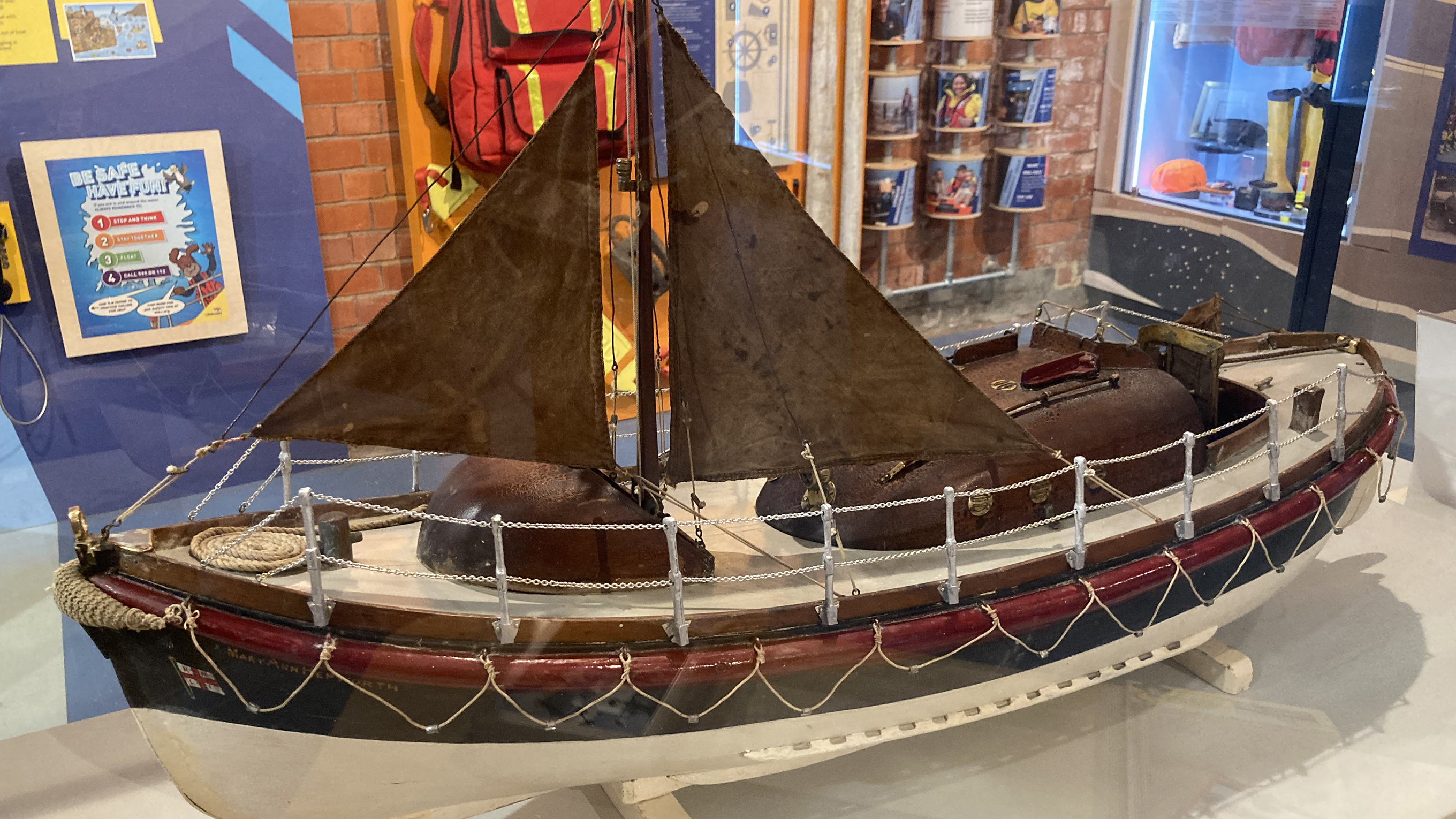

A model maker’s dream: the Mary Ann Hepworth
From fixing the wire rigging to restoring the tiny sails, retired Whitby Coxswain Pete Thomson transforms an historic lifeboat model passed down through the generations.
Ask anyone where you can find retired Whitby Coxswain Pete Thomson MBE and you’ll likely get the same answer: in his workshop. Pete himself says he spends ‘half his life’ in his workshop, a converted garage at his home in Ruswarp, near Whitby.
It’s a space he describes as ‘packed to the rafters with bits and pieces of everything’ and where a certain kind of alchemy takes place. With painstaking attention to detail, 85-year-old Pete lovingly restores wrecked old lifeboat models into objects of beauty, which are displayed at the Whitby RNLI Lifeboat Museum – where Pete was previously curator and which his father, Eric, founded in 1958.
Pete’s most recent restoration project was the 1938 model of the Mary Ann Hepworth lifeboat, which served at Whitby between 1938 and 1974, launching 372 times and saving 201 lives. The model was originally built in 1938 by the station Mechanic, Jim Philpott. It was presented to the then station Secretary, Mr Foster, when he retired in 1940 after 44 years. The model remained in Mr Foster’s family until 2023, when his granddaughter kindly donated it to the Whitby RNLI Lifeboat Museum. The model holds special meaning to Pete; not only had it been built by one of his predecessors at the station, it was also a lifeboat on which Pete was a crew member and mechanic.
‘The model came to me in quite a state,’ says Pete. ‘It had been in a loft for years and everything from the deck to the cabin covers was covered in decades of grime. The railings were gone, the rigging for the mast was a tangled mess of wires and there were parts missing, including one of the brass ventilators.’
Restore and repair
Squirrelled in his workshop with his trusty bandsaw, chisels, hammers, drills and powerfile (handy for shaping wood quickly), Pete very carefully washed and wiped the model with cotton buds to remove surface dirt and reveal the paint underneath before he could start repairing it. ‘This was quite difficult to do; you’ve got to be careful with very old things like that. It was made in 1938 – the same age as me!’ he says. ‘Once it was completely cleaned, I had to carefully repair and replace all the things that were missing, and I had to rebuild the railings. I looked all over the model making magazines and couldn’t find the stanchions for the railings anywhere. I had plenty of old chain of that scale, but I didn’t have the stanchions. I don’t have a lathe, so I had to make them out of plywood. You have to get really close to see that they’re not professionally made!’
Pete carefully cleaned and straightened the original sails, replaced the wire rigging and the brass ventilators, and made a fairlead for the rope to go through out of a chunk of brass he had in his drawer. He replaced the ropes and cleaned up the drogue that Jim Philpott had made from a piece of leather. ‘I renovate models back to what they would have been, as near as possible, without taking the age away from them,’ he says. ‘I don’t repaint. I clean them up and repair them carefully – it’s a bit like that TV programme The Repair Shop!’
Man and boy
Pete’s love of modelling stems from childhood. A room in his house was devoted to his father’s O gauge trainset, complete with 3ft wide shelving all around the sides and in the middle of the room. From 8 years old, Pete joined in with his father’s hobby, building models of farmyards, castles and docks, to go with the trainset. When he joined the army, Pete left modelling behind for 7 years, but on his return to Whitby in 1964, he joined his father once again in building models – this time of the Rohilla, the hospital ship that struck Whitby Rock in 1914 – for the Whitby RNLI Lifeboat Museum that his father had established.
‘My father had a tobacconist shop and he lived above it,’ Pete explains. ‘He had the model of the Rohilla wreck and the lifeboat rescuing people from it set out on a big table. My job was the scenery and I made the sea around the wreck with a bucket of papier maché. The whole model was made for next to nothing - cardboard boxes from the sweet shop, bits and bobs of wood and old pipes for funnels.’
When Pete’s father retired as curator of Whitby RNLI Lifeboat Museum, Pete took over and created scale models and dioramas, which were displayed in beech, glass-fronted cabinets. He built dioramas including the 1861 Whitby disaster, when all lifeboat crew apart from one, Henry Freeman, drowned, after going to the aid of vessels in distress. Another was of the overland launch in January 1881, when a storm drove a vessel onto the rocks at Robin Hood’s Bay. Because of conditions, the Whitby lifeboat couldn’t get there by sea, so volunteers and horses carried the Robert Whitworth lifeboat 6 miles over a hill in deep snow, for 2 hours, to fulfil the rescue. ‘I included the details,’ says Pete. ‘The pub on the hill, the snow, and the lifeboat with all the little men carrying it.’
Pride of place
One factor that helped Pete with restoring the Mary Ann Hepworth model is that, in 1967, he was invited to join the Mary Ann Hepworth lifeboat crew as mechanic. His role, which was full-time and came with a salary of £14 a week, included keeping the boat clean, polishing the brass, looking after the engine and doing any repairs - so he knew the boat inside out. In 1974, when the RNLI decided Whitby should have a new, more powerful boat, and the Mary Ann Hepworth came out of service, some of the older crew members retired and Pete became second coxswain before moving on to be coxswain until he was retired in 1993. ‘If you’d told me in 1964 that I’d be coxswain, I wouldn’t have believed you,’ he says.
The Mary Ann Hepworth model that Pete restored now has a pride of place in the Whitby RNLI Lifeboat Museum in the central display cabinet. Preserving history is important to Pete, especially in the RNLI’s 200th year, as well as helping the public and the next generation learn about Whitby RNLI’s heritage. Restoring the models is also about preserving and displaying the character of the lifeboat model and model makers themselves. ‘We had a professional scale model of the Mary Ann Hepworth lifeboat in the museum, but we decided to display the one I repaired instead because it had a story to it and because it was made by the lifeboat mechanic in 1938. It’s more characterful because it was made by an amateur.’
Pete’s character certainly shines through his restorations – his patience and love of the lifeboat and heritage are what helps make Whitby RNLI Lifeboat Museum such a popular destination. And what now for Pete? He’s in his workshop of course, working on his next project – models passed to him by the museum’s new curator and a replica of his house for his great-great-grandchildren, made from anything he can lay his hands on. ‘With being a mechanic for 27 years and not throwing stuff away, I’ve gathered up a lot of things,’ he says. ‘You name it, I’ve got it - and I’ll put it to good use.’
Whitby remembers
At 9pm on 3 February 1940, in total darkness during a wartime blackout, the Mary Ann Hepworth launched to the rescue of a Belgian steamer in distress near Saltwick, just south of Whitby. The sea conditions were horrendous, but the lifeboat managed to get alongside the stricken vessel, where 10 were onboard. However, a huge wave struck the lifeboat and, sadly, Crew Members John Dryden and Christopher Wale were washed overboard and lost. The lifeboat returned to station where a second crew was assembled. They launched twice more in the total darkness and huge seas, but to no avail. Eventually the Rocket Brigade managed to get four men from the steamer to shore. In honour of the crews’ brave attempts to save lives at sea in the face of terrible conditions, Mechanic James Philpott received a Silver Medal for Gallantry and Bronze Medals were awarded to Coxswain James Murfield, Acting Second Coxswain John Dryden (posthumously), Acting Bowman Christopher Wale (posthumously), Assistant Mechanic William Dryden and crew members John Walker and Matthew Winspear.
You may also enjoy the following










